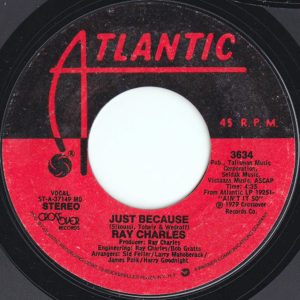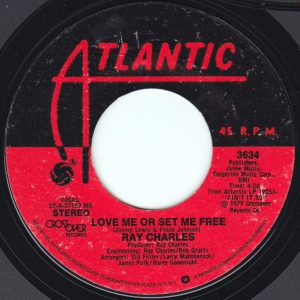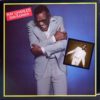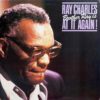Ain’t It So
Album by Ray Charles
Ray Charles released the album Ain’t It So in September 1979, an astounding collection of varied recordings that ended Ray’s 1970s career on a decided high note.
Having tried his hand at disco on much of 1978’s Love And Peace album, here Ray dials down the disco (though not all the way) and goes back to the grab-bag of styles that he always loved. Nothing is too old or arcane or unexpected for him: if it resonated with him, and he thought he could do it justice, any song was open as far as Ray was concerned.
Of course, his persona ties the performances together, sewing them into a seamless whole that benefits from the arrangements of Sid Feller, Larry Muhoberac, James Polk, and Harry Goodnight. Equally vital is Ray’s own mixing, which is what he spent most of his time on when crafting his music. Endless weeks sat listening and tweaking would finally yield what he considered the perfect balance of each instrument and each voice.
Ain’t It So‘s reception
With such an enjoyable range of music presented at such a high standard, it’s a condemnation of popular taste in 1979 that Ain’t It So was largely ignored upon its release. Ray had clearly lost none of his interpretive abilities nor passion for music. But the world wasn’t listening; his long-time fans perhaps preferred the old stuff, while younger audiences regarded Ray as outdated.
He did, at least, see the commercial failure and critical pummeling of Ain’t It So from a healthy and perhaps more realistic perspective:
I’m Ray Charles! Who cares what they write in the paper? What matters is the people working in the kitchen of the places I play – they like me.
Thankfully, modern ears needn’t be concerned with contextual tastes, and we are able to listen to the album and judge it now based on its artistic merits alone. By that measure, Ain’t It So is an especially fantastic Ray Charles record, a collection of performances that holds up beautifully from start to finish.
About the songs on Ain’t It So
The songs that Ray chose to perform on Ain’t It So extend over a hearteningly wide range of styles and moods, like many of the best Ray albums. There is no unifying theme per se, but the LP shows off a masterfully arranged and executed diversity of music that works whether or not you’re familiar with the songs or not.
None of the songs on Ain’t It So was written by Ray Charles, as had long been custom for him.
Side 1 begins with Rogers and Hammerstein’s 1949 classic “Some Enchanted Evening”, but Ray completely bypasses the earnest sentimentality of most versions of the showtune and makes it a discofied, breathlessly rocking opening salvo. It’s a nice bridge between the overt disco of Love And Peace and the mix of styles to come on Ain’t It So.
“Blues In The Night”, from the 1941 film of the same name, stretches out over six minutes to allow Ray to settle into a breathtaking blues performance, his voice cackling with a gravelly life and a rich, world-weary bemusement.
I’ve been in some big towns
Heard me some big talk
A young French fan, Jean-Pierre Grosz, had cornered Ray during a trip to Paris and given him a tape of his friend Robert Fitoussi’s music. Ray liked it, and Fitoussi’s emotional “Just Because” ended up as the final song on Side 1 of Ain’t It So. A tightly-wound, horn-led drama, “Just Because” has a stateliness achieved by Ray’s growling vocals and an elegiac arrangement.
Irving Berlin’s 1923 classic “What’ll I Do” opens Side 2 of Ain’t It So, and Ray starts the song with a tease: over dense orchestration, he sings the opening lines in a slow, delicate voice, and it seems that this will be a slowly unfolding performance along those lines. But suddenly a fast drumbeat drifts in and “What’ll I Do” morphs into a fast sax-led disco boogie. Its instrumental sections make it more like a jazz showcase, though an eccentrically playful electric guitar adds a pop element while the male backing chorus recalls some of Ray’s earliest R&B music for Swing Time records.
One of Ray’s more audacious choices comes in Barry Manilow’s “One Of These Days”, but the Genius takes Barry’s saccharine 1973 original and elevates it to majesty. The heartfelt singing and the bracing drama of the tune are offset by the cold brush-off of the lyrics; it’s a complex brew of emotions that only a master like Ray Charles could pull off.
“Love Me Or Set Me Free” is pure rhythm and blues, with Jimmy Lewis’ playful and adventurous tune bolstered by a jaunty brass section and some especially tuneful Raelets. With his women encouraging him from behind, Ray indulges in some patented ecstatic grunts and funny asides.
Another pop cover from 1973 comes in the form of “Drift Away”, a Top Ten hit for Dobie Gray. The simple round-and-around chord sequence and the hand-clapping singalong elements of the famous version are kept intact by Ray, although he adds an interesting little saxophone lick in the chorus and strangles his voice into a more soulful tone.
Ain’t It So ends with a country song: Don Williams’ 1975 smash hit “(Turn Out The Light And) Love Me Tonight”. Echoing the singalong of “Drift Away”, Ray here overdubs multiple tracks of his own voice, a somewhat startling effect he would pursue with more panache on some of his early 1980s songs for Columbia. A light string section and Ray Charles’ own electric piano drive the song instrumentally.
Record covers
Ain’t It So features an image of Ray Charles, a stylized line drawing of Ray in a tuxedo in his classic head-back, big-grin pose, all contours except the filled-in sunglasses. Garish late-1970s lettering announces the album title much more prominently than the artist’s name, which is represented in a thin font that is repeated upwards from the bottom, each time getting fainter.
The most notable feature, obviously, is the bright, flat orange color that extends across the entire front and back covers. The image of Ray, but thankfully not necessarily the orange hue, would be used for posters, concert tickets, and T-shirts over the years.
The liner notes contain few credits; only Ray and his four arrangers plus engineer Bob Gratts get a mention. (The arrangers aren’t matched with which songs they worked on.) The album was Ray’s third since rejoining Atlantic Records in 1977, though it was also a Crossover album. The catalog number is SD 19251.
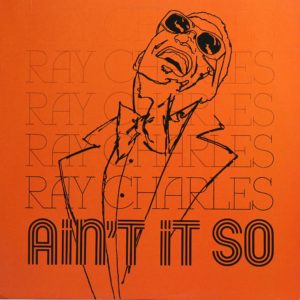
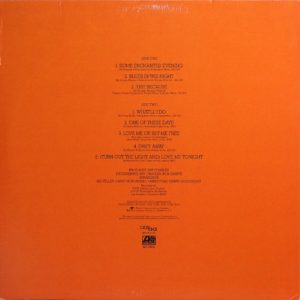
Record labels
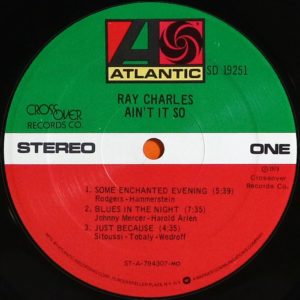
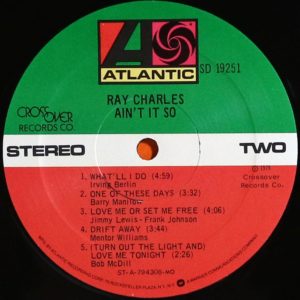
Singles with songs from Ain’t It So
Track listing
Side A
1. “Some Enchanted Evening”
2. “Blues In The Night”
3. “Just Because”
Side B
1. “What’ll I Do”
2. “One Of These Days”
3. “Love Me Or Set Me Free”
4. “Drift Away”
5. “(Turn Out The Light And) Love Me Tonight”
